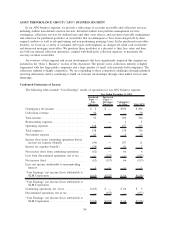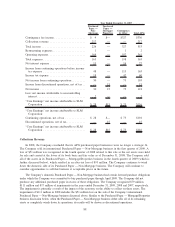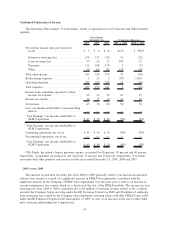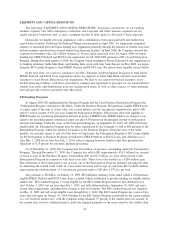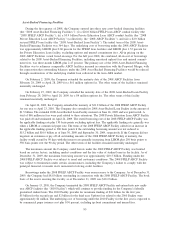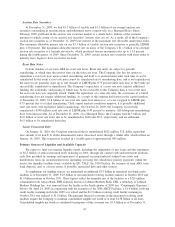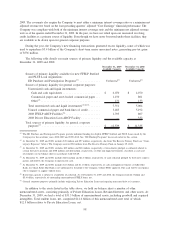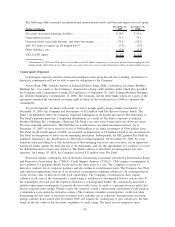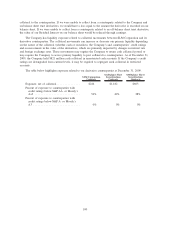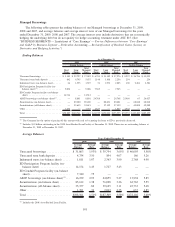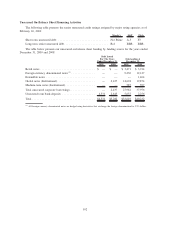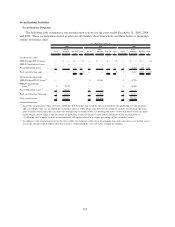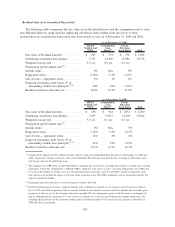Sallie Mae 2009 Annual Report Download - page 95
Download and view the complete annual report
Please find page 95 of the 2009 Sallie Mae annual report below. You can navigate through the pages in the report by either clicking on the pages listed below, or by using the keyword search tool below to find specific information within the annual report.the notes will be repaid with funds from the Federal Financing Bank (“FFB”). The FFB will hold the notes for a
short period of time and, if at the end of that time the notes still cannot be paid off, the underlying FFELP loans
that serve as collateral to the ED Conduit will be sold to ED through the Put Agreement at a price of 97 percent of
the face amount of the loans. As of December 31, 2009, approximately $14.6 billion face amount of our Stafford
and PLUS Loans were funded through the ED Conduit Program. For 2009, the average interest rate paid on this
facility was approximately 0.75 percent. As of December 31, 2009, there are approximately $820 million face
amount of additional FFELP Stafford and PLUS Loans (excluding loans currently in the Participation Program)
that can be funded through the ED Conduit Program.
Additional Funding Sources for General Corporate Purposes
In addition to funding FFELP loans through ED’s Participation and Purchase Programs and the ED
Conduit Program, the Company employs other financing sources for general corporate purposes, which include
originating Private Education Loans and repurchases and repayments of unsecured debt obligations.
Secured borrowings, including securitizations, asset-backed commercial paper (“ABCP”) borrowings, ED
financing facilities and indentured trusts, comprised 82 percent of our Managed debt outstanding at
December 31, 2009 versus 78 percent at December 31, 2008.
Sallie Mae Bank
During the fourth quarter of 2008, Sallie Mae Bank, our Utah industrial bank subsidiary, began expanding its
deposit base to fund new Private Education Loan originations. Sallie Mae Bank raises deposits primarily through
intermediaries in the retail brokered CD market. As of December 31, 2009, total term bank deposits were
$5.6 billion and cash and liquid investments totaled $2.4 billion. As of December 31, 2009, $4.2 billion of Private
Education Loans were held at Sallie Mae Bank. We ultimately expect to raise additional long-term financing,
through Private Education Loan securitizations or other financings, to fund these loans. In the near term, we expect
Sallie Mae Bank to continue to fund newly originated Private Education Loans through long-term bank deposits.
ABS Transactions
On January 6, 2009, we closed a $1.5 billion 12.5 year asset-backed securities (“ABS”) based facility. This
facility is used to provide up to $1.5 billion term financing for Private Education Loans. The fully-utilized cost of
financing obtained under this facility is expected to be LIBOR plus 5.75 percent. In connection with this facility,
we completed one Private Education Loan term ABS transaction totaling $1.5 billion in the first quarter of 2009.
The net funding received under the asset-backed securities based facility for this issuance was $1.1 billion.
In 2009, we completed four FFELP long-term ABS transactions totaling $5.9 billion. The FFELP
transactions were composed primarily of FFELP Consolidation Loans which were not eligible for the ED
Conduit Program or the Term Asset-Backed Securities Loan Facility (“TALF”) discussed below.
During 2009, we completed $7.5 billion of Private Education Loan term ABS transactions, all of which were
private placement transactions. On January 6, 2009, we closed a $1.5 billion 12.5 year asset-backed securities
(“ABS”) based facility. This facility is used to provide up to $1.5 billion term financing for Private Education
Loans. The fully utilized cost of financing obtained under this facility is expected to be LIBOR plus 5.75 percent.
In connection with this facility, we completed one Private Education Loan term ABS transaction totaling $1.5 billion
in the first quarter of 2009. The net funding received under the asset-backed securities based facility for this
issuance was $1.1 billion. In addition, we completed $6.0 billion of Private Education Loan term ABS transactions
which were TALF-eligible. See “Term Asset-Backed Securities Loan Facility (“TALF”)” below for additional
details. Although we have demonstrated our access to the ABS market in 2009 and we expect ABS financing to
remain a primary source of funding over the long term, we expect our transaction volumes to be more limited and
pricing less favorable than prior to the credit market dislocation that began in the summer of 2007, with
significantly reduced opportunities to place subordinated tranches of ABS with investors. At present, while the
markets have demonstrated some signs of recovery, we are unable to predict when market conditions will allow for
more regular, reliable and cost-effective access to the term ABS market.
94




